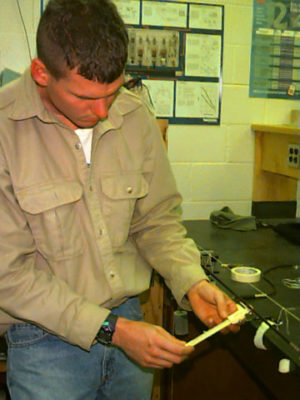Comprehensive Fly Line Study Through WCU
I became interested in conducting the comprehensive fly line study through WCU due to instructing and guiding full time. It was apparent that there was some vast difference in how various lines performed. Fly lines will have no doubt changed since 1995 but the factors studied are significant today. Rio, SA, Cortland, Monic, and Airflo have some good info on their products online. All of the company pages provide some great food for thought on various line tapers. There are so many choices available today!
The fly line study was designed to test the varying brands for friction, the specific gravity of the material, and elasticity. The fly lines used for the study included 150 cm of the running line section (5-weight forward fly lines). The front taper of the line was investigated as well, but difficult to test because of the taper differences.
Friction Test
A Pasco photographic timer (model ME9215A) was used for the friction test with a time gate span of 71 cm. The line had a 70-gram weight attached at one end, which fell through the time gates. The rollers circumference was .79 cm and the weight on the top roller was 39.5 grams. The rollers enabled the fly line to have a contact point at all times when shooting through the gates.
The significance of the COF test measurement will become greater when actually shooting greater line distances. Look for the lines that achieve the lowest COF tests to reduce the amount of effort needed to shoot greater line distances. The COF tests give a pretty good representation of the coating quality of the fly lines tested. Other important considerations are line diameter, stiffness, and how they react with extreme temperatures.
Specific Gravity Test
The lower the number indicates that the material will float higher or longer on the water’s surface. The higher the number above one is indicative of a material that will sink quickly when placed in water. Look for the lowest figure of specific gravity to float the line the highest.
Fly Line Tips
The fly line tip sinking has been a problem for decades until recently. Many companies use a loop of fly line fused together at the tip now. This helps prevent water absorption. The loop also aids in twice as much flotation at the tip. The use of small metal leader pins, 12 turn nail knots with Pliobond, or cutting off the fly line loops all lead to sinking the tips quicker.
My favorite method for all of my lines uses the Dave Whitlock method for joining lines together, leader, leader to the line, and many other possibilities. You need a #9 embroidery needle, a pin vise, zap-a-gap and a piece of Emory cloth. The splice takes less than two minutes with a bit of practice! Check out Dave’s website to order one as I am sure you will enjoy being rid of the bump, bump, bump when bringing your line in and out of your guides.
Elasticity Test
The elasticity test used 150 cm sections of the fly line. Gripping jaws stretched the line with a spring of 25 pounds. The supple materials attain a greater stretch ratio. They also had fewer memory coils when pulled from the reel. We also used various temperature extremes to see how the line memory changed. Tournament casters and sub-surface anglers often prefer a line with low stretch. A very heavy line, such as used in tournament casting, reacts like spaghetti and is difficult to maintain loop face stability when elasticity remains high. Most anglers tend to choose lines with a stretch ratio between 5%-6%. The big-game anglers tend to use lines with greater stretch to prevent early break-offs.
The inner core influences memory of coils depending on climate. Cores fall into either braided or solid mono cores. A solid mono core will perform poorly in colder climates.

